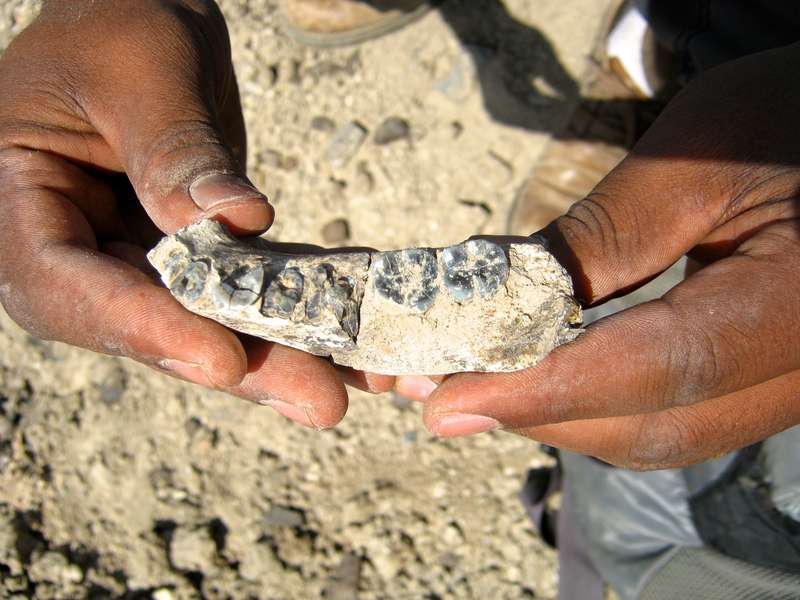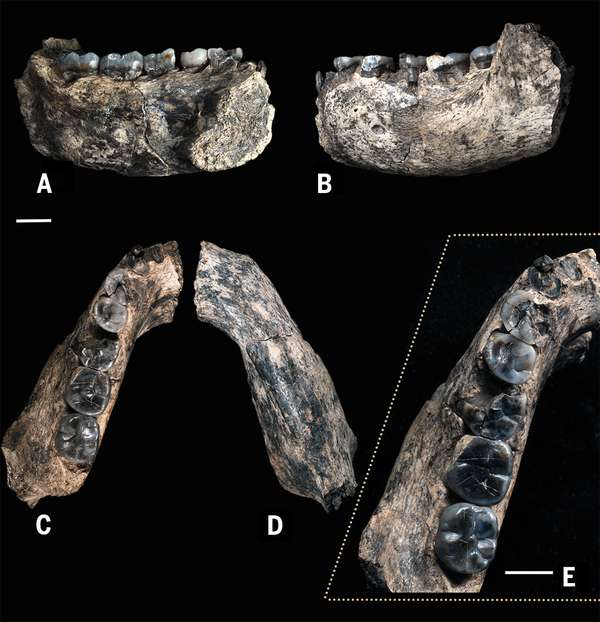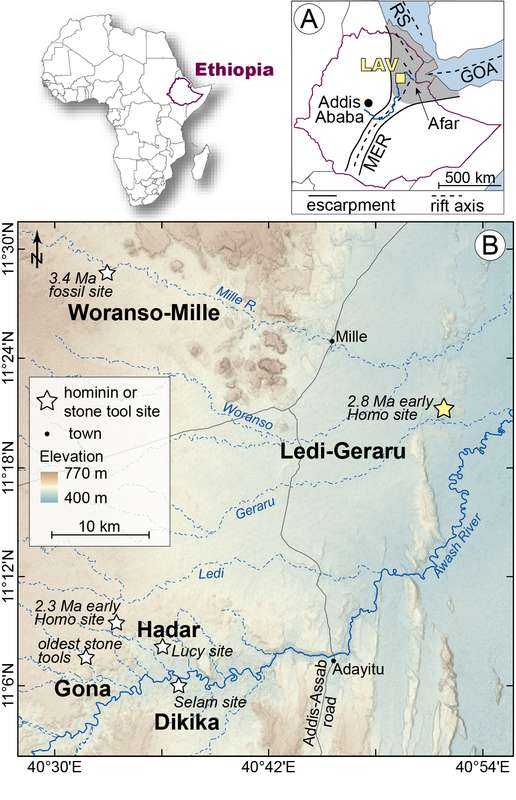Oldest Homo Fossil Implies Humans Created by Climate Change
 On an East African hill somewhere in “Afar,” a stone’s throw from “Awash,” two sections of a large detached jawbone grinned brokenly at Ethiopian Arizona State University (ASU) graduate student Chalachew Seyoum. The pieces were just lying there, so the student picked them up and brought them together. They fit “perfectly,” he said.
On an East African hill somewhere in “Afar,” a stone’s throw from “Awash,” two sections of a large detached jawbone grinned brokenly at Ethiopian Arizona State University (ASU) graduate student Chalachew Seyoum. The pieces were just lying there, so the student picked them up and brought them together. They fit “perfectly,” he said.
They in turn would serve to bring together the primitive Australopithecus Aferensis lineage of the famous Lucy fossil, and ours. For that refashioned jawbone was the oldest fossil of the homo genus ever found, ASU and University of Nevada (UN) scientists—including Seyoum—announced at a global presser for two Science papers describing the find.
The jawbone’s age was radiometrically set at 2.8 million years. This was 400,000 years older than the human genus was supposed to be. But the smallish teeth and parabolic jaw were unmistakably Homo. Since Lucy’s kind died out 2.9 million years ago, this meant our genus popped up in prehistory earlier and more suddenly than known, in only 100,000 years. It all fit beautifully with the climate change known to have occurred at that time—which, like a giant hand it now appeared, swept small-brained, unimaginative eaters like Lucy off newly vast and arid savannas, and swept on to them more large-brained, omnivorous types: us.
Backing this up: the other Science paper, which reveals that one-third of mammals at that time were new to earth. So some 200,000 years before a known climate change, a swath of Ethiopia was made up of a rich mosaic of trees and grasslands, and populated by monkeys and other tree-friendly animals like giraffes. Within a short time—as a result of dizzying 20,000-year-cycles of wet-dry climate change— animals more suitable for a world that had been flattened, dried out, and opened up, were now galloping about: fast-moving grazers like gazelles, wild pigs, zebras, and us.
Amazing discovery
“This is an amazing discovery, one that is going to set the tone for sorting out our past environmental changes,” Columbia University paleo-climatologist Peter deMenocal told Bioscience Technology. He was not involved in the Science studies. “We’ve known for a long time that 2.8 million years was a critical time in terms of changes in the environment. Several of us had hypothesized that maybe some of the important changes we saw in human ancestors, and other mammals at this time, may have been the result of environment changes. But the fossil record had a gap.”
 Continued deMenocal: “That is one reason we are so excited. These studies make it really clear that right around 2.8 million years ago was a time when homo first appeared. Our biggest challenge was a huge gap that occurred in Ethiopia right about 2.5 to 3 million years ago. The geologic record was missing; a key part of the geologic record of human evolution didn’t exist. That is what is so transformative about these studies. A really big juicy puzzle piece was missing. These two papers put it back.”
Continued deMenocal: “That is one reason we are so excited. These studies make it really clear that right around 2.8 million years ago was a time when homo first appeared. Our biggest challenge was a huge gap that occurred in Ethiopia right about 2.5 to 3 million years ago. The geologic record was missing; a key part of the geologic record of human evolution didn’t exist. That is what is so transformative about these studies. A really big juicy puzzle piece was missing. These two papers put it back.”
The teeth were key to the puzzle, as their small size and shape indicated a broader diet than the coarse vegetable diet of earlier breeds like the so-called “Nutcracker Man.” “The homo diet was more varied,” deManocal said. Aiding this was, no doubt, the stone tools appearing at the time.
“These two studies focus all this evolutionary action on a narrow window 2.8 million years ago, that magic time in the climate,” deManocal concluded to Bioscience Technology. Members of Homo flourished because they could “develop a flexible diet from an increasingly flexible landscape…In 100,000 years or less, a wink of geologic time, two new hominin lineages appeared, one the Robust Australopithecines, and the other us. It is a major explosive branching point, a time of intense speciation, species turnover, and behavioral adaptations including the origins of stone tools. We expected this, and now these papers show this major climate change was indeed a time of major evolutionary change.”
Exemplary integrative approach
Jonathan Wynn, a University of South Florida geologist who is also an (uninvolved) expert on this period, told Bioscience Technology the new work “is an exemplary integrative approach to the paleobiological study of early human evolution.” The approach of the teams, whose lead authors were UN’s Brian Villmoare and Penn State University’s Erin DiMaggio, “is truly multidisciplinary, integrating research on the anatomical details of these crucial fossils with their geological, paleoecological, and chronological context.
"The meagerness of the fossil record of vertebrates in eastern Africa deriving from rocks dating to between three and two million years ago has long been a `thorn in the side’ of those working to reconstruct the big picture of early hominin evolution. Crucially, we have long known that the transition from the more chimpanzee-like Australopithecus to our own genus Homo is likely to have occurred somewhere in this fossil gap. This new work has begun to fill this gap, not only with well-dated hominin fossils, but with data on their relationship to the ancient environment in which our new genus emerged.”
Wynn thinks the Homo creatures represented by the jawbone “perhaps” did not appear more rapidly than thought, but “certainly sooner than had been  previously interpreted from the sparse fossil record of this period. The new fossils date to 2.8 to 2.75 million years ago, while previous evidence for Homo was confined to about 2.4 to 2.3 million years ago; thus the new fossils push back the age of earliest Homo by more than 15 percent of the previously known record.”
previously interpreted from the sparse fossil record of this period. The new fossils date to 2.8 to 2.75 million years ago, while previous evidence for Homo was confined to about 2.4 to 2.3 million years ago; thus the new fossils push back the age of earliest Homo by more than 15 percent of the previously known record.”
Wynn said the sparse sedimentary record of three to two million years ago “left us previously with a critical gap in the fossil record of early hominins. The new fossils from remote parts of the Awash Valley, Ethiopia begin to fill that gap with crucial fossil material.”
Importantly, he said, “the geological and vertebrate paleontological work represented in these papers gives us a much more sharply focused picture of the environment in which Homo emerged from earlier australopithecines. The brief snapshots provided by the sediments exposed here, combined with work in surrounding areas, gives us a 'big picture' view of a lake basin in which the mesic environments surrounding Lake Hadar were beginning to dwindle, compared to previous periods in which Australopithecus (Lucy kin) thrived for almost a million years. The new evidence shows that the largely wooded lakeside environments were replaced by more open environments likely covered with low shrubs and grasses."
Returning to Afar
There is much more to be done, Wynn said. Researchers need to establish a causal link between this regional environmental trend, “and the biological changes represented by the Australopithecus to Homo transition. And we will need to learn more about the fundamental causes of regional environmental change in this sedimentary basin. Was it driven by global climate change known during this period, or regional shifts in the motions of tectonic plates that shifted the positions of ancient lake basins and river systems?”
It is likely, he said, that researchers will be returning to Afar for answers to many new questions “posed by these exciting new discoveries.”
Establish your company as a technology leader. For 50 years, the R&D; 100 Awards, widely recognized as the “Oscars of Invention,” have showcased products of technological significance. Learn more.

